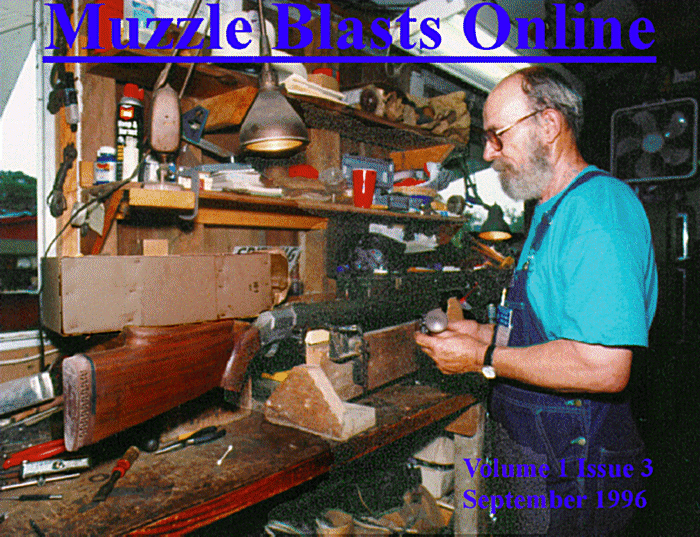|
Muzzle Blasts Online |
|
...for the muzzleloading enthusiast |
|
The muzzleblasts.com domain, subdomains, content, etc., are neither affiliated with the NMLRA nor its paper magazine Muzzle Blasts |
|
Muzzle Blasts Online |

|
|
|
|
|
|
A Plain Southern Longrifle

|
|
This plain Southern rifle is little more than a lock, a stock, and a barrel. |
The slightly down-turned point at the rear of the lock mortise is the first characteristic of note. The wrist area is long and slender with a three-screw barrel tang extending almost to the termination of the comb area. The hand-forged iron trigger guard has a graceful outline and is held to the stock with two wood screws. The front trigger is filed to a triangular shape along its face and has a slight inward curve at its tip. Both of these elements are found on many Virginia and Carolina rifles. The grease hole, another Southern trait, is only one-half inch in diameter.

|
|
Note the down-turned point at the lock mortise, the graceful lines of the trigger guard, and the very small grease hole in the stock. |
The cheekpiece is well-pronounced due to the deep concave formed between the molding and the stock comb. The comb of the rifle terminates into the wrist area with a graceful little teardrop shape a typical Carolina detail.
There is no side-plate. The mouth of each lock-bolt hole is reinforced with a brass washer. Directly behind the rear extension of the trigger guard are two holes; one has been plugged with a wooden splinter. Most collectors insist that these holes held vent picks make from turkey quills, but they may have been made by screws or nails that held one end of a makeshift sling. The other end of the sling would have been a simple loop around the barrel of the rifle. Many early hunting rifles of Teutonic origin used fabric slings fastened to the stock on metal button-headed" screws threaded into the belly of the stock in the same area as the holes on this rifle. Whatever their purpose, the holes are seen quite often on Southern longrifles.

|
|
The three-screw tang extends nearly to the termination of the comb, which in turn ends in the wrist area with a teardrop shape. |

|
|
Brass washers reinforce the mouth of each lock-bolt hole; no side-plate on this simple rifle. Note also the pronounced cheekpiece. |

|
|
Two holes behind the trigger guard may have held quill vent-picks. The author poses that instead they may have been made by screws or nails holding one end of a simple fabric sling. |
"Poor boy" is a trite term used by modern-day collectors to describe this type of rifle. A more correct term would be a "plain rifle" or a "common rifle." It was a tool of the frontiersman, as was an axe or plow; and like those tools it was used up to nothing over generations of hard work. In my opinion, it is the true Kentucky rifle, and to find one in its original condition is extremely rare.
Bibliography:
- Bivins, John Jr.
- Longrifles of North Carolina. York, Pennsylvania: George Shumway Publisher, 1968.
- Ivey, William W.
- "Schools of Gunsmithing in North Carolina." Kentucky Rifle Asssciation Newsletter, Fall 1984.
- Whisker, James B.
- Gunsmiths of the Carolinas. Bedford, Pennsylvania: Bedford Village Press, 1994.
- Whisker, James B.
- Gunsmiths of Virginia. Bedford, Pennsylvania: Bedford Village Press, 1995.